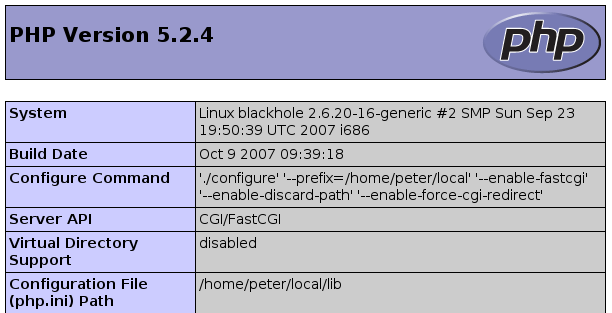How To Install Lighttpd For Mac
Apache is the world's most popular web server and is a very good piece of software. It isn't however, the only choice of free software and open source web server solutions and it's easy to overlook lightweight alternatives to Apache. One such alternative is.
Here's what its official site says about the project: Security, speed, compliance, and flexibility - all of these describe lighttpd (pron. Lighty) which is rapidly redefining efficiency of a webserver; as it is designed and optimized for high performance environments. With a small memory footprint compared to other web-servers, effective management of the cpu-load, and advanced feature set (FastCGI, SCGI, Auth, Output-Compression, URL-Rewriting and many more) lighttpd is the perfect solution for every server that is suffering load problems. And best of all it's Open Source licensed under the revised BSD license.
In this tutorial, I am going to show you how to get lighttpd up and running by compiling it from source. You can of course use your distribution's package manager to install it, but here we'll go through the source-based process.
First of all, we need to head over to the Lighttpd website and download the latest source code. At the time of writing, that is 1.4.18, and the download link is. $ wget Once that's downloaded, we'll extract the archive (substitute xjvf for xzvf and the relevant filename in the next command if you downloaded the tar.gz version): $ tar xjvf lighttpd-1.4.18.tar.bz2 Now, we need to change into the newly extracted directory (change your version numbers if necessary): $ cd lighttpd-1.4.18 The install is a standard source-based process.

If you're familiar with that, then go ahead. For everyone else, the sequence is to run the following commands in order (obviously letting the first one finish before starting the second one and so on). $./configure $ make Finally, you need to run make install as root. On Ubuntu, run sudo make install. Everywhere else, do this: $ su -c 'make install' Enter your root password (or your user password in the case of Ubuntu) and confirm.
That's the basic installation now done, so let's get our server up and running! Before we do that, however, we have to get a configuration file in place and set up. Depending on your exact requirements, you'll need to have a configuration file for you. In this example, I'm going to use a very basic configuration file to get us up and running as soon as possible. You can find more help on making configuration files.
Server.document-root = '/var/www/' server.port = 80 server.username = 'www-data' server.groupname = 'www-data' mimetype.assign = ( '.html' = 'text/html', '.txt' = 'text/plain', '.jpg' = 'image/jpeg', '.png' = 'image/png' ) static-file.exclude-extensions = ( '.fcgi', '.php', '.rb', ', '.inc' ) index-file.names = ( 'index.html' ) Save your configuration file as /etc/lighttpd/lighttpd.conf. Back on your command line, login as root. For Ubuntu, use sudo -i or su - for everyone else. We now need to start the server daemon for the first time.
# lighttpd -D -f /etc/lighthttpd/lighttpd.conf You should get a message along these lines: 2007-09-14 20:30:25: (log.c.75) server started That means your server started up successfully and you should now be able to browse to on your machine and view whatever is in /var/www (or whatever you chose as your root for the web server). Now you can get populating this directory with content! Posted on 04 October 2007 at 09:45 AM Guys, sorry if my question here is very basic because I new to this.
I tried the above tutorial and received this error. What should I do? Here it is: drasmadi@drasmadi-kubuntu:/lighttpd-1.4.18$./configure checking build system type. I686-pc-linux-gnulibc1 checking host system type. I686-pc-linux-gnulibc1 checking target system type. I686-pc-linux-gnulibc1 checking for a BSD-compatible install.
/usr/bin/install -c checking whether build environment is sane. Yes checking for a thread-safe mkdir -p. /bin/mkdir -p checking for gawk. No checking for mawk.
Mawk checking whether make sets $(MAKE). Yes checking whether to enable maintainer-specific portions of Makefiles. No checking for gcc. Gcc checking for C compiler default output file name. Configure: error: C compiler cannot create executables See `config.log' for more details.

Drasmadi@drasmadi-kubuntu:/lighttpd-1.4.18$. Posted on 04 October 2007 at 04:54 PM Oh, forget the above error messages, it didn't recognise the ' character when I copied the text directly from your blog. I edited the ' and now it run but unfortunately it hanged as follows: root@drasmadi-kubuntu:# lighttpd -D -f /etc/lighttpd/lighttpd.conf 2007-10-05 07:45:57: (log.c.75) server started It doesn't return the prompt back to me.
How To Install Lighttpd For Mac Mac
Is this normal? When I typed in my browser it returned 404 - Not Found The are already some php files there under /var/www/ Any idea? Posted on 04 August 2010 at 07:05 AM I followed what you did but there was no error and also the server did not started. I did cd /usr/src/lighttpd-1.4.x/./configure make make install There was no init script for lighttpd. So what do I do also /usr/src/lighttpd-1.4.x/doc/lighttpd.conf does not exist instead /usr/src/lighttpd-1.4.x/doc/config/lighttpd.conf is there.
Ubuntu Install Lighttpd
Apart from this the init script for lighttpd seemed to be in /usr/src/lighttpd-1.4.x/doc/initscripts/rc.lighttpd and copying this to /etc/init.d/rc.lighttpd did not helped me. So what do I need to do?